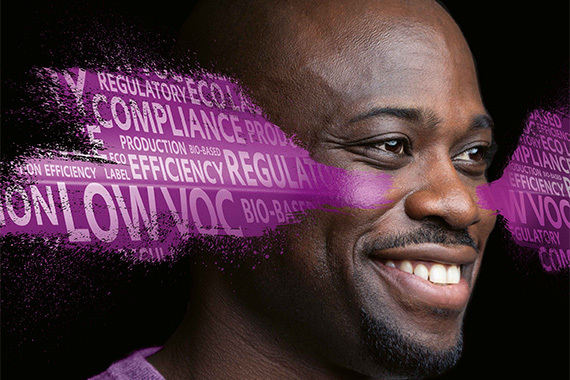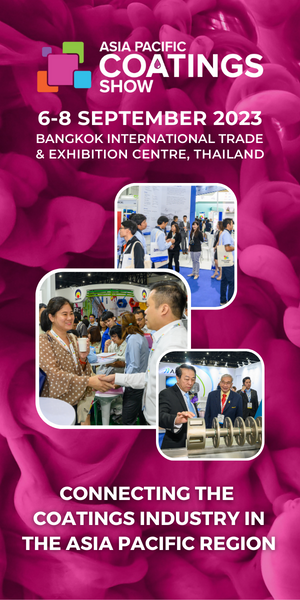
Sustainability in the coatings and inks industry is often reduced to "bio-based solutions." However, to evaluate a coating’s true environmental impact, many more aspects need to be considered than only assessing if a solution is "bio-based." To address this challenge, Evonik has developed a strategy that goes far beyond its own additives by putting the formulation and the final product itself as the focus of all its activities. Under the claim "Sustainability goes deeper than the surface,” Evonik’s Coating Additives business line introduces its new holistic approach to sustainability that minimises the environmental footprint and maximises the handprint of the final coating.
Sustainability is about the consistent viability of saving time, materials, and energy
"Sustainability is about so much more than just being green,” says Gaetano Blanda, Head of Evonik Coating Additives. "It’s about the consistent viability of saving time, materials, and energy. We are convinced that to produce truly sustainable products the formulation itself must be more environmentally friendly and safer.” Accordingly, Evonik Coatings Additives bundles its new sustainability approach into seven so-called handprint effects. "The handprint of a product is the difference between an established and an improved condition of a single environmental impact,” describes Tim-Frederic Sloot, Head of Sustainability at Evonik Coating Additives. "For example, when our product enables the formulator to significantly reduce the VOC content in a coating’s footprint – then the difference to the VOC content in the reference coating is the handprint of our additive.” The business line has defined seven different effects which outline potential handprints for its products and solutions. These seven handprint effects influence different steps of the value chain – from the manufacturing, via the end use of coated or printed articles to the disposal or recycling.
The role of handprints in the coatings industry
There are four handprint effects that focus mainly on the formulation and application step of coatings and inks. These four effects are "Safe Use,” "Production Efficiency,” "VOC Reduction,” and "Sustainable Feedstocks.” Concerning safe use, Evonik’s Coating Additives team proactively carries out individual actions to reduce safety related risks of its portfolio, for example by replacing hazardous components. To improve production efficiency, solutions are offered that optimise and reduce the amount of material and utility needed from customers, for example by reducing energy usage during the grinding step of a formulation. Providing solutions for VOC reduction is already a core competency of Evonik, and the existing portfolio of additives and resins that serve this purpose is continuously expanded. The increasing number of bio-based products included in Evonik’s portfolio further addresses the growing need to replace fossil raw materials with more sustainable feedstocks.
The next two handprint effects of "Durability” and "Labels/Compliance” have their highest relevance in the end use phase of coated articles. A more durable coating significantly reduces the need for maintenance or replacement, resulting in substantial savings of raw materials and emissions. Evonik’s high-performance additives improve corrosion, scratch, and/or burnish resistance. To address the "Labels/Compliance” effect, Evonik’s regulatory experts evaluate the suitability of relevant products for compliant coatings and inks, providing customers with extensive regulatory information for the whole portfolio.
The seventh and last handprint effect, "Circular Solutions”, focuses on the end of life of coated and printed articles. As a key member of Evonik’s Circular Plastics Program, the Coating Additives business line focuses the development of its portfolio on circular solutions for paints, coatings and inks.
Minimising the footprint
Besides maximising the handprint, the Coating Additives business also minimises its footprint throughout all its processes by using resources more efficiently and reducing emissions.
For that purpose, a comprehensive Portfolio Sustainability Assessment (PSA) using the framework of the World Business Council for Sustainable Development (WBCSD) is carried out. Based on the PSA, it is possible to identify products that have a clear positive sustainability profile, which are then named as "Next Generation Solutions.” It is also possible to identify products with critical sustainability profiles and initiate actions to improve the profile. As of today, approximately 50% of Evonik’s coating additives portfolio are classified as next generation solutions.
Reduction of greenhouse gas emissions
Evonik’s efforts to reduce its own greenhouse gas emissions also includes increasing the transparency of its processes. This is done by monitoring the specific energy use and material streams at individual production sites and by Life Cycle Assessments (LCAs) on a product level. In a next step, experts from Evonik’s Technology & Engineering department will also identify the most attractive reduction potentials and carry out projects to realise them. "Our holistic approach enables our customers to contribute to a much more sustainable coatings and inks industry,” added Tim-Frederic Sloot.
The Coating Additives business line’s sustainability approach is part of the entire Evonik group’s overall Sustainability Strategy. This strategy is based on ambitious targets and key activities to translate them into measurable actions. Sustainability forms an integral part of the strategy and commercial activities of Evonik and all of its business lines, with the company systematically focusing on the impact of its business activities along the entire value chain and based on the UN’s Sustainable Development Goals.
Evonik is one of the leading companies in the chemical industry for sustainability, backed up by the results of some of the most important independent rating and ranking agencies (for example, MSCI, Sustainalytics, EcoVadis, CDP).




